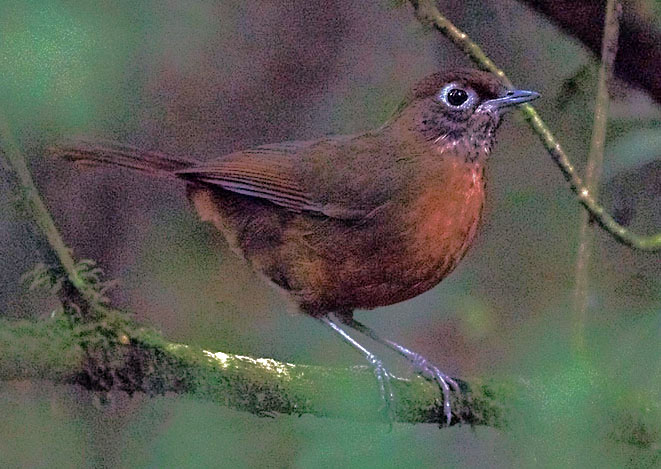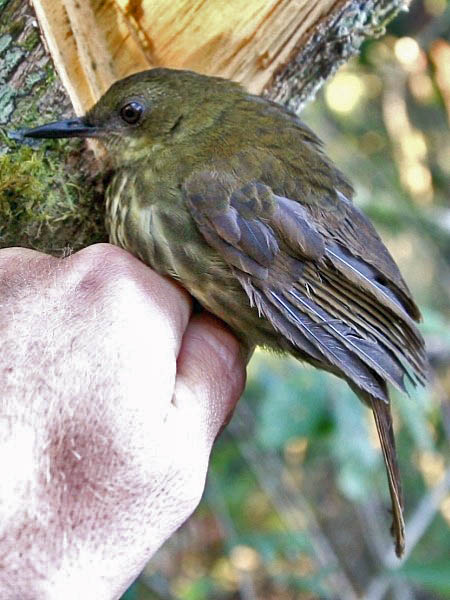
a web page by Don Roberson |
SPOT-THROAT & ALLIES Modulatricidae |
|
Among them is Spot-throat (left, a nice shot by Tony Palliser), an undergrowth skulker of the eastern arc mountains that run from northeast Tanzania to northern Mozambique. |
At various times in the past, Spot-throat was thought to be a thrush or a bulbul, Dapple-throat had been placed with chats or bulbuls, and Gray-chested Babbler had been considered a thrush. This netted bird is Dapple-throat (photo right, an in-hand bird to be banded and released). At one time it could be found in the Usambara Mts. of northeastern Tanzania, but it has disappeared from all the "known" locations in recent years. A few continue to be located in the Udzungwa Mts. and nearby ranges in southeastern Tanzania, but numbers seem lower. It is not clearly known when this clade split from the Sugarbirds. Beresford et al. (2005) estimated the split at between 28 and 39 million years ago [mean 28 mya] but that estimate is a dozen years out of date and needs recalibration. We also could use a clearly understanding of the species in this group. Are there more species to be included? Comparatively little is known about these three species. Gray-chested Babbler (genus Kakamega) is resident in shady montane forests, usually near streams, where it lives on or near the ground singly or in pairs. It often follows swarms of army ants (Dorylus). Spot-throat and Dapple-throat are also ground-dwellers, probing leaf litter or flicking leaves with the bill. Dapple-throat is also said to be ant-follower at times. Spot-throat hops or runs along the forest floor with tail held slightly elevated. Both apparently feed on invertebrates and berries (Collar & Robson 2007). |
In June 2018, Rita and I visited the West Usambara Mountains of Tanzania in hopes of seeing Spot-throat with our guide Anthony Raphael. The location chosen was this patch of forest edge at about 1500m (5000' elev.) in the Mzuki Forest Reserve. A pair of Spot-throat were singing in the dense undergrowth to the right of the trail in this photo (left). One could crawl up into that undergrowth and sit quietly; the Spot-throats circled us, singing quite a bit, and we recorded its song on our iPhones. Yet they kept in the shadows and provided only quick glimpses (no photos obtained). Still — it was thrilling to have this rare bird nearby and singing; some observers suggest it sounds like an Old World oriole. |
Photos: Tony Palliser photographed the Spot-throat Modulatrix stictigula in the West Usambara Mts., Tanzania, in Oct 2017. The in-hand photo of Dapple-throat Arcanator orostruthus is from Udzungwa Mountains NP, Tanzania, on 2 July 2007; via Wikipedia Commons it is credited to L. Hansen of USFWS, and is in the public domain. The site where we saw Spot-throat was in the Mzuki Forest Reserve, West Usambara Mts., Tanzania, on 4 June 2018. Bibliographic note: There is no "family book" for this new family; some basics about the 3 species in this family are in Collar & Robson (2007). Literature cited:
|
 The Modulatricidae is composed of three obscure "thrush-like" or "babbler-like' birds from east and central Africa. Before molecular research they were considered to be aberrant babblers (e.g., Collar & Robson 2007). Two species — Spot-throat and Dapple-throat — were initially discovered through DNA analysis to be unrelated to babblers or thrushes. Instead, they were most closely related to the Sugarbirds of southern Africa [
The Modulatricidae is composed of three obscure "thrush-like" or "babbler-like' birds from east and central Africa. Before molecular research they were considered to be aberrant babblers (e.g., Collar & Robson 2007). Two species — Spot-throat and Dapple-throat — were initially discovered through DNA analysis to be unrelated to babblers or thrushes. Instead, they were most closely related to the Sugarbirds of southern Africa [ There is still much to be learned about this set. Some global checklist (e.g., IOC) elevated them to Family level in 2012 as the Arcanatoridae. More recently, Birdlife International and a book of bird families (Winkler et al. 2016) also accepted that status, but used the name Modulatricidae for the family. Apparently the "Arcanatoridae" was never properly proposed in formal format [a formal publication of Modulatricidae is in Winkler et al. 2016]. The members of the Modulatricidae are:
There is still much to be learned about this set. Some global checklist (e.g., IOC) elevated them to Family level in 2012 as the Arcanatoridae. More recently, Birdlife International and a book of bird families (Winkler et al. 2016) also accepted that status, but used the name Modulatricidae for the family. Apparently the "Arcanatoridae" was never properly proposed in formal format [a formal publication of Modulatricidae is in Winkler et al. 2016]. The members of the Modulatricidae are: